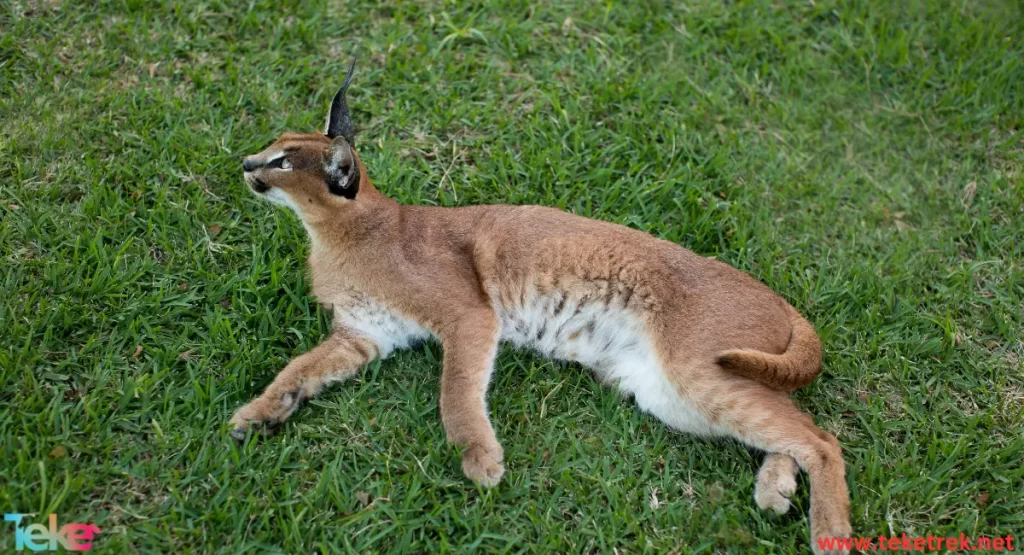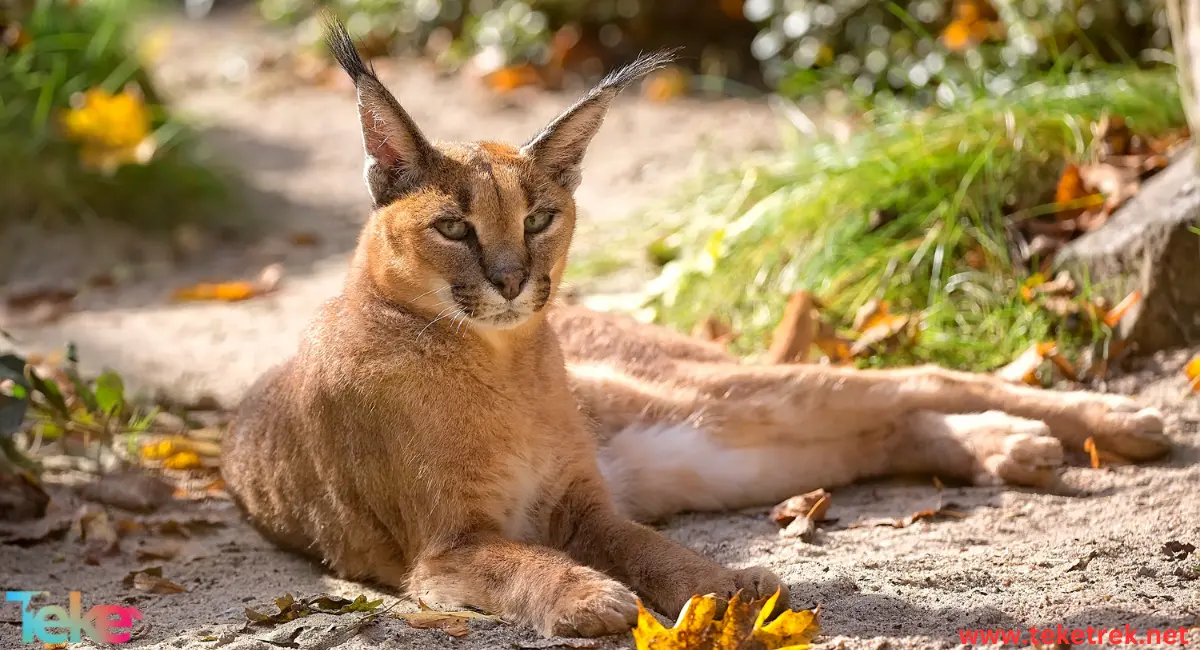The caracal, or caracal, is an impressive carnivorous mammal, characterized by its attractive appearance and unique behavior. Despite its small size, it is considered a strong and skilled animal in hunting prey.
The caracal’s ability to adapt to harsh environmental conditions and its hunting skills are the reason for its success as an eye-catching and interesting animal. In addition, the caracal is an animal of great environmental importance, as it contributes to the balance of the ecosystem and the preservation of biodiversity in the areas in which it lives. Let’s talk about it in more detail in today’s article from Tiki Trek.

An introduction to the caracal
The caracal is a carnivorous mammal (meat-eater) that belongs to the Felidae family, classified with the small cats, but it is the heaviest and fastest.
The caracal belongs to the wild cat family, and lives in different regions of Asia and Africa.
The caracal is characterized by its long ears and gray-brown fur color, which gives it an elegant and attractive appearance.
The caracal feeds on a variety of small animals and birds, making it an essential part of the food chain in the environments in which it lives.
Thanks to the caracal’s role as a natural predator, it contributes to regulating the numbers of small animals and birds, which maintains the stability of the ecosystem and the health of ecosystems.
Scientific classification
Kingdom: Animals
Phylum: Chordates
Class: Mammals
Order: Carnivores
Family: Felidae
Genus: Lynx or ground hugger
Locations of the caracal
The lynx lives in many countries around the world, but mainly in dry and desert areas.
The lynx can be found in countries such as South Africa, Iran, Afghanistan, and Pakistan, in addition to India, Iraq, Turkmenistan, Uzbekistan, and China.
The caracal lives in a variety of habitats: plains and open savannahs, semi-deserts and desert areas, especially in the widespread mountain ranges, forests and scrublands, as well as dense evergreen and even mountain forests.
What are the characteristics of the caracal?
The caracal has several names, including the groundhog, caracal, and desert lynx. It is characterized by the following:
The caracal is a large, medium-sized cat, with a strong body with long limbs.
The caracal’s body is covered with thick fur of a color ranging from brown to red.
The abdomen of the caracal is light brown, dotted with pale gray spots.
The caracal has a short tail with dense fur that is the same color as the body, and is less than half the length of its body.
The caracal is distinguished by its large ears, at the tip of which stand out erect black hair strands.
The caracal has a spherical head (similar to the shape of a domestic cat’s head), and it has front feet that have 5 toes, while the hind feet are larger than the front ones with 4 toes, all equipped with retractable claws
Male caracals are larger than females.
What is the food of the caracal?
The caracal’s diet depends mainly on rabbits, rodents, antelopes and small monkeys, in addition to birds such as pigeons and partridges.
The lynx may also eat some insects and molluscs, but these are not a common part of its diet.
The lynx’s menu varies depending on its geographical distribution, as in Africa it may eat larger animals such as ungulates, while in Asia it may be limited to consuming small vertebrates such as rodents.
The lynx is famous for its amazing leaps to catch birds, especially during its hunt.
In general, the African lynx is an important part of the ecosystem in the areas where it lives, as it plays a role in regulating animal numbers and maintaining the balance of the ecosystem.
Feeding this animal on other animals contributes to controlling their numbers and preserving biodiversity in the region.
the importance of the lynx to the environment and ecosystem
The earth hugger (caracal) is of great importance in the environment and ecosystem for several reasons, including:
1. Ecosystem balance: The lynx is considered an important part of the food chain in the environment, as it is a predator of small animals such as rabbits, birds, and insects. Therefore, it plays a vital role in regulating the numbers of these organisms and maintaining the balance of the ecosystem.
2. Protecting biological diversity: The presence of the lynx contributes to protecting biological diversity by preventing the spread of harmful organisms and controlling the numbers of some other organisms that may negatively affect the ecosystem.
3. Its effect on plants: The lynx can also affect the distribution of plants in the area in which it lives through its effect on the numbers of animals that feed on these plants.
4. Its role in the cycle of elements: The presence of the lynx contributes to the cycle of elements in nature, through the decomposition of the corpses of animals that it preys on and the recycling of organic materials into the soil.
In general, it can be said that the presence of the lynx is necessary to maintain balance in the ecosystem and ensure the continuity of life in the area in which it lives.

FAQs about longing
Is the ground hugger a predator?
Yes, the ground hugger is considered a predator, but it is also selective in its eating, as it does not approach the internal intestines of the prey, while it can eat the feathers of small birds and rotten meat.
Is a lynx a pet?
No, the lynx is a carnivorous predator.
How much does a ground hugger cost?
Its price ranges from 8 to 10 thousand US dollars.
How many lynxes are there ?
There are about 240,000 species worldwide.
Ultimately, caracals display diverse aspects of nature’s beauty, as these magnificent creatures reflect the importance of maintaining ecological balance and the coexistence of organisms in the natural environment.
Therefore, we must all work together to protect these magnificent creatures and preserve the diversity of life on our planet for future generations. Let us be guardians of nature and contribute our efforts to preserving this beautiful world and all the creatures that adorn it.





